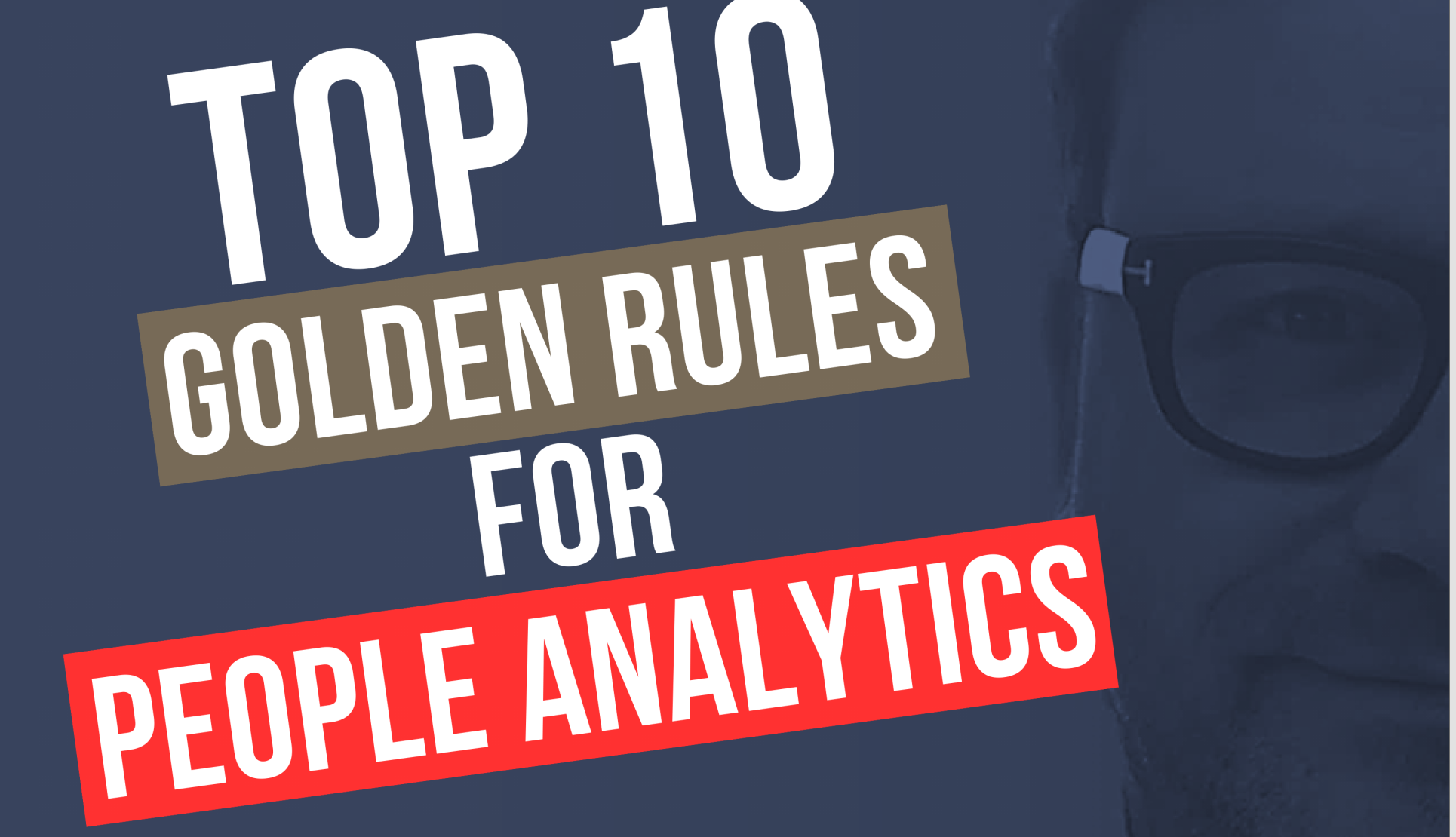
It is time for an update on my previous posts on the 10 golden rules of people analytics, simply because so much has happened since then. For example, continuous employee listening, artificial intelligence (AI in HR), agile HR, employee experience, strategic workforce management, and hybrid working are just a few emerging topics in recent years listed in Gartner's hype cycle for HR transformation (2023).
In the last year, I have spoken to many people working in different organisations on establishing people analytics as an accepted practice. I have also joined some great conferences (HRcoreLAB, PAW London & Amsterdam) where I learned from excellent speakers. I also (re)engaged with some excellent people analytics and workforce management vendors, such as Crunchr, Visier, eQ8, AIHR, One Model, Mindthriven, and Agentnoon. Finally, I also enjoyed having multiple elevating discussions with some thought leaders who influenced my thinking (e.g., David Green, Rob Briner, Jonathan Ferrar, Dave Millner, Sjoerd van den Heuvel, Ian O'Keefe, Brydie Lear, Jaap Veldkamp, RJ Milnor, and Nick Kennedy).
These encounters and my ongoing PhD research on adopting people analytics resulted in a treasure trove of new ideas and knowledge that confirmed my experience and beliefs that it is all about creating an embraced people analytics practice using a systemic approach in supporting HR in becoming more evidence-based. So, like I said, it's time for an update. I hope you enjoy and appreciate the post, and I invite you to engage and react in the comments or send me a direct message.

It is obvious but not a common practice that your people analytics portfolio needs to align or fit with your strategic organisational goals. A strong strategic FIT ensures you execute people analytics projects with the most value and impact on your organisation. It is, therefore, important to integrate the decision-making on where to play in people analytics with your periodic HR prioritisation process.
Strategic workforce management and continuous employee listening are pivotal in prioritising the right strategic workforce issues
The bigger picture is that two people analytics-related HR interventions, strategic workforce management and continuous employee listening, are pivotal in prioritising the right strategic workforce issues. By blending the insights from these HR interventions, you ensure you are prioritising based on the voice of the business and the voice of the employee. See also my previous post on strategic workforce management. Because people analytics is at the core of these HR interventions and provides many additional strategic insights, I argue we need a new HR operating model where the people analytics practice is positioned at the centre of HR.
I argue that we need a new HR operating model where the people analytics practice is positioned at the centre of HR

Based on my experience and research, I strongly advise integrating all evidence-based HR services into one function. See also my previous post on establishing a people analytics practice. This integration will enhance the speed and quality of your people analytics delivery, make you a trusted analytical strategic advisor, and make you a more attractive employer for top people analytics talent. All other people analytics function setups seem like compromises.
With evidence-based HR services, I refer to activities such as reporting, advanced analytics, survey management, continuous employee listening, organisational design and strategic workforce management. It is hardly ever that a strategic question is answered by only one of these services. In most cases, you will need to combine survey management (i.e., collecting new data), perform advanced analytics (i.e., build a predictive model), and share the outcomes in a dashboard (i.e., reporting) or build new system functionality based on the models (e.g., vacancy recommendation).
You will need to combine various people analytics services to provide real strategic value

Because the people analytics practice is maturing, it deserves a clear target operating model. In a target operating model, you clarify to the organisation whom you consider your clients, what services or solutions you can deliver, what service levels your clients can expect, and when and how you will deliver the solution.
Being transparent about your target operating model will build trust and legitimacy in your organisation. Inspired by the work of Insight222, a people analytics target operating model consists of a demand engine (understanding and prioritising demand), a solution engine (e.g., data management, building models, designing surveys), and a delivery engine (e.g., dashboards, advisory with story-telling, bringing models to production), ideally covering all the evidence-based HR services mentioned under rule 2 in this post. Additionally, more practices are applying agile principles to increase time-to-delivery and are using some form of release management to balance capacity.

Compliance with data privacy regulations has been an important topic since the early days of people analytics ten years ago. Even before the GDPR era, organisations did well to understand when personal data could be collected, used, or shared. Legislation such as GDPR offers guidance and more structure to organisations on how to deal with data privacy issues.
Being fully compliant is not where responsible data handling ends
However, being fully compliant is not where responsible data handling ends. Simply because you can, according to data privacy regulations, doesn't mean you should. There are also contextual and ethical elements to take into account. For example, being able and regulatory-wise allowed to build an internal sourcing model matching internal employees with specific skills with internal vacancies doesn't mean you should. From a cultural or business continuity perspective, creating internal mobility may not be beneficial or desired in specific areas of your organisation. Assessing the implications of using data analytics in a broader context than just regulations will also enhance the needed trust and legitimacy.

Having a mature people analytics practice that delivers high-quality, evidence-based HR services is not enough to ensure value creation for your organisation. Suppose your organisation, including your HR community, struggles to translate business opportunities into analytical services or finds it hard to use data and insights on a daily basis in their decision-making. In that case, upskilling is a necessary intervention.
HR upskilling in data-driven decision-making is a necessity in growing towards a truly evidence-based HR culture
Creating awareness of the various analytical opportunities, developing critical thinking, creating an inquisitive mindset, identifying success metrics for HR interventions and policies, evaluating these metrics, and understanding the power of innovative data services, such as generative AI, is essential. When upskilling, be sure to recognise the different HR roles and their needs and preferences. For example, your HR business partners will likely want to develop their skills in identifying strategic workforce metrics and strategic workforce management. However, your COE lead (i.e., HR domain leads) wants to develop their ability to collect and understand internal clients' feedback and improve their HR services (e.g., recruitment, learning programs, leadership development). So, diversify your learning approach to make it more effective.

There is enormous value in integrating your HR and business data in a structured matter. Integrated enterprise-wide data allows you to combine, improve, share, and analyse data more efficiently. More organisations are using data warehouse and data lake principles to create this central enterprise-wide data infrastructure based on, for example, Microsoft Azure or Amazon Web Services technology.
A mature people analytics team is best equipped to create an HR data strategy and manage the corresponding data pipeline.
HR would do well to improve its capability to manage the data pipeline by hiring data engineers. It is an interesting discussion about where to position this data management capability and related skill set. The first thought is to position this capability close to the HR systems and infrastructure function. This setup might work perfectly. However, based on your HR context and maturity, I argue that the people analytics practice is a good and sometimes better alternative. Mature people analytics teams are likely more able to think about data management and creating data products and services built with machine learning models. Traditional HR systems and infrastructure teams may tend to focus too much on the efficiency of the HR infrastructure (e.g., straight-through processing, rationalising the HR tech landscape).

Successful people analytics or evidence-based HR services excel in product design. Whether built with PowerBI or vendor-led BI platforms (e.g., Crunchr, Visier, One Model), dashboards must be user-friendly, easy to navigate, and motivate users to work with data in their decision-making. The same applies to functionality based on machine learning models, such as chatbots, learning assistants, or vacancy recommendations. The user design, the functionality provided, and the flawless and timely delivery all contribute to maximising the usage of these analytical services and, ultimately, decision-making.
Strong product design and thinking requires product owners to have a marketing mindset
As important as the product design is product thinking by the product owner. A product owner for, e.g., recruitment or leadership programs, should be constantly interested in hearing what internal clients think about their products. This behaviour requires product owners to have a marketing mindset. As part of a larger continuous listening program, an internal client feedback mechanism should provide the necessary information to improve your products and services continuously. A product owner should be curious about questions like: Are your internal clients satisfied? Should we tailor the products for different user types? What functionality can we improve or add?

When a solution looks good and makes sense based on your analytics, management tends to go for an immediate big-bang implementation. However, don't be afraid to experiment and learn before rolling out your solution to all possible users. Starting with a minimum viable product (i.e., MVP) allows you to evaluate your product among a select group of users early in the development process. Based on feedback, you can enhance your product incrementally (i.e., agile) manner.
It also enables you, when valuable, to compare treatment groups with non-treatment groups. These types of experiments (i.e., difference-in-difference comparisons) help you to evaluate the effect the new product intends to have. People analytics services can support this incremental approach, testing a minimal viable product (MVP) and obtaining feedback to provide additional insights that may avoid a big implementation failure of your new products.

Today, artificial intelligence (AI) is predominantly based on machine learning (ML). These AI-ML models provide powerful functionality such as vacancy and learning recommendations, chatbots, and virtual career or work schedule assistants. There is no need to fear these applications, but having a deeper understanding of them is necessary. However, implementing these types of functionality without checking and validating them is risky and, therefore, unwise.
A mature people analytics practice allows you to build your own machine-learning-based AI functionality
A mature people analytics practice allows you to create and build these AI functionalities internally. You can also buy AI functionality by implementing a vendor tool, but please ensure you do not end up with a new vendor for each AI functionality you desire. If you choose to buy AI functionality, the people analytics team should act as a gatekeeper. Internally built machine learning models are subject to checks and balances. And rightfully so. However, the same should apply to ML-based AI functionality from external providers. The people analytics team should check the performance and validity of the model and control for biases in the data and legal and ethical justification.

If you are the people analytics leader within your organisation, it might be daunting or reassuring to hear that you can make the difference between failure and success. You bring the people analytics practice alive by reaching out to stakeholders, developing your team, understanding your clients, learning from external experts, and building a road map to analytical maturity.
A successful people analytics practice starts with the right people analytics leader
As a people analytics leader, you should excel in business acumen, influencing skills, strategic thinking, critical and analytical thinking, understanding the HR system landscape, understanding the possibilities of analytical services, project management, and, last but not least, people management (as all leaders should). The result of having all these capabilities is that a people analytics leader, together with the people analytics team, becomes a trusted advisor to senior management, understands the most pressing issues within an organisation, can effectively manage the HR data pipeline, and can build new analytical services to enhance decision-making and ultimately drive organisational performance and employee well-being.
I hope you enjoyed my update on the 10 golden rules for establishing people analytics practice. If you enjoyed the post, please hit ? or feel invited to engage and react in the comments. Send me a direct message if you want to schedule a virtual meeting to exchange thoughts one-on-one.
Thanks to Jaap Veldkamp for reviewing.





 扫一扫
添加客服
扫一扫
添加客服




